NVIDIA GeForce GTX 760 Review: The New Enthusiast Kepler
by Ryan Smith on June 25, 2013 9:00 AM ESTCompute
Jumping into compute, we aren’t expecting too much here. Outside of DirectCompute GK104 is generally a poor compute GPU, and the loss of an SMX relative to the GTX 660 Ti isn’t doing the GTX 760 any favors here. By all appearances the GTX 760 is even more of a pure gaming card than the GTX 660 Ti was.
As always we'll start with our DirectCompute game example, Civilization V, which uses DirectCompute to decompress textures on the fly. Civ V includes a sub-benchmark that exclusively tests the speed of their texture decompression algorithm by repeatedly decompressing the textures required for one of the game’s leader scenes. While DirectCompute is used in many games, this is one of the only games with a benchmark that can isolate the use of DirectCompute and its resulting performance.

Civilization V once more validates that NVIDIA’s DirectCompute performance is generally up to snuff in this case. The fact that the GTX 760 is ahead of the GTX 660 Ti by any degree took us by surprise at first, but we’re likely looking at a scenario where the wider memory bus and/or larger L2 cache of GTX 760 offset some of the general compute gap.
Our next benchmark is LuxMark2.0, the official benchmark of SmallLuxGPU 2.0. SmallLuxGPU is an OpenCL accelerated ray tracer that is part of the larger LuxRender suite. Ray tracing has become a stronghold for GPUs in recent years as ray tracing maps well to GPU pipelines, allowing artists to render scenes much more quickly than with CPUs alone.
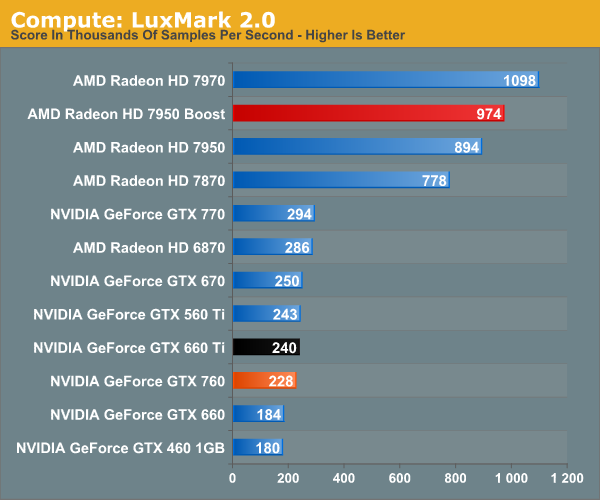
Luxmark is entirely about compute performance, and as a result this is an exceptionally poor showing for the GTX 760, with the GTX 660 Ti having no trouble besting it.
Our 3rd benchmark set comes from CLBenchmark 1.1. CLBenchmark contains a number of subtests; we’re focusing on the most practical of them, the computer vision test and the fluid simulation test. The former being a useful proxy for computer imaging tasks where systems are required to parse images and identify features (e.g. humans), while fluid simulations are common in professional graphics work and games alike.
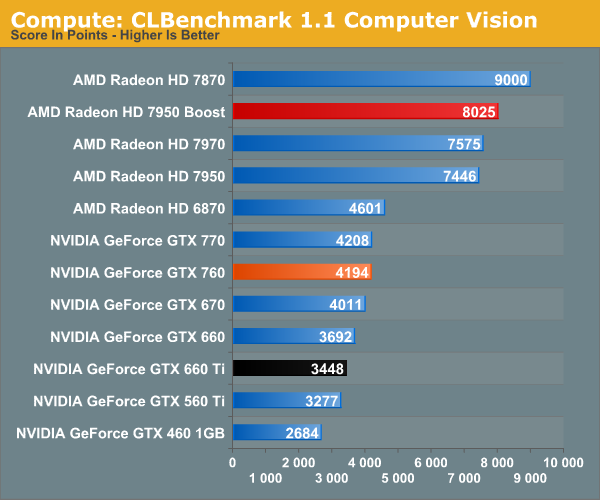

Breaking down our CLBenchmark results, the computer vision test has frequently favored raw clockspeed over total shader throughput, which gives the GTX 760 an interesting advantage here. It’s capable of easily leaving the GTX 660 Ti in the dust and even edge out the GTX 670. Of course this is still less than 2/3rds the performance of even the slowest AMD GCN card, reflecting AMD’s superior computer performance.
The fluid simulation is especially brutal in that regard. Once again shifting back to an almost complete reliance on shader throughput, GTX 760 slightly trails GTX 660 Ti, never mind the nearly three-fold difference between it and the 7950B.
Moving on, our 4th compute benchmark is FAHBench, the official Folding @ Home benchmark. Folding @ Home is the popular Stanford-backed research and distributed computing initiative that has work distributed to millions of volunteer computers over the internet, each of which is responsible for a tiny slice of a protein folding simulation. FAHBench can test both single precision and double precision floating point performance, with single precision being the most useful metric for most consumer cards due to their low double precision performance. Each precision has two modes, explicit and implicit, the difference being whether water atoms are included in the simulation, which adds quite a bit of work and overhead. This is another OpenCL test, as Folding @ Home has moved exclusively to OpenCL this year with FAHCore 17.
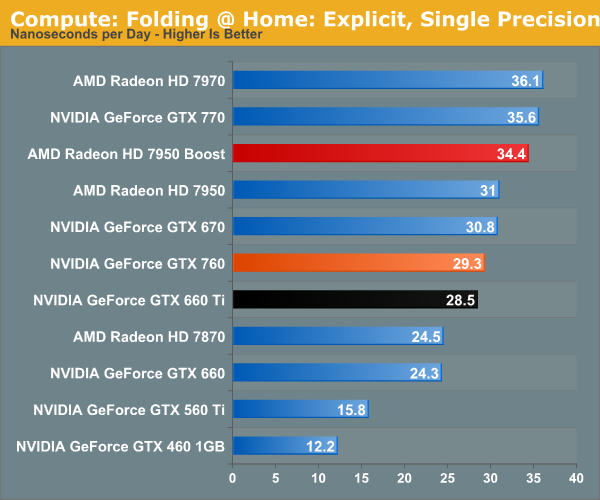
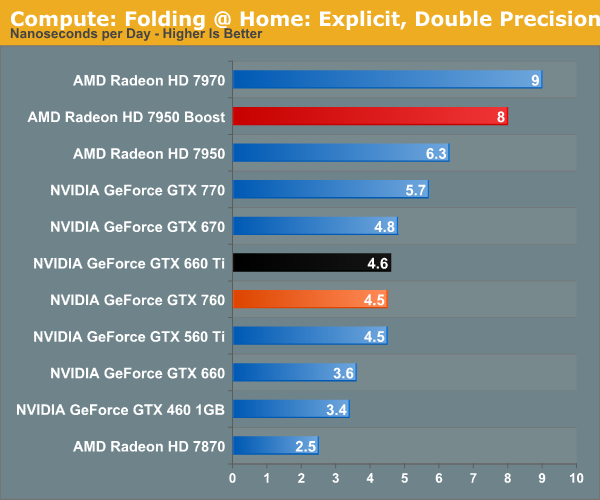
Unlike some of our other compute benchmarks, the GTX 760 doesn’t fare too poorly here when it comes to single precision. However it’s still notably behind the 7950B in this case. And with double precision it’s no contest.
Wrapping things up, our final compute benchmark is an in-house project developed by our very own Dr. Ian Cutress. SystemCompute is our first C++ AMP benchmark, utilizing Microsoft’s simple C++ extensions to allow the easy use of GPU computing in C++ programs. SystemCompute in turn is a collection of benchmarks for several different fundamental compute algorithms, as described in this previous article, with the final score represented in points. DirectCompute is the compute backend for C++ AMP on Windows, so this forms our other DirectCompute test.
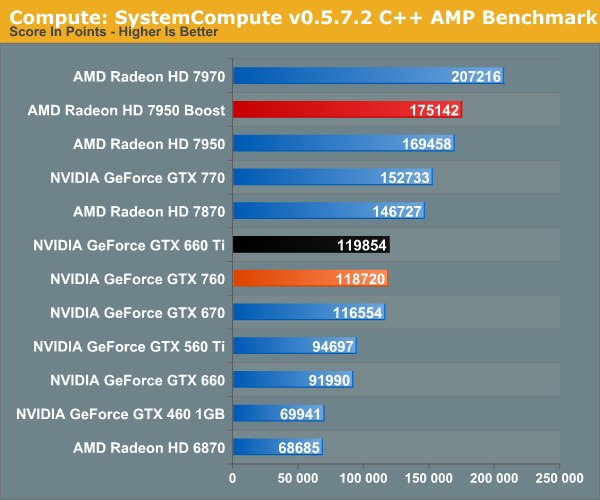
As another compute throughput bound benchmark, the GTX 760 is essentially tied with the GTX 660 Ti. This benchmark is somewhat memory bandwidth sensitive, which is why the GTX 760 doesn’t outright lose to the GTX 660 Ti here.










110 Comments
View All Comments
Aditya211935 - Tuesday, June 25, 2013 - link
I guess I m a bit early.A5 - Tuesday, June 25, 2013 - link
Looks pretty solid for the price.Samus - Tuesday, June 25, 2013 - link
I feel like an idiot buying a 660Ti two months ago for $300. At least I got the 3GB version that'll be "somewhat" future-proof for BF4 as the maps are expected to tax 2GB cards.gamoniac - Tuesday, June 25, 2013 - link
Don't look back. You can only make your decision based on the information you had and your needs at the time. If you could look just 2 minutes ahead, you would be a billionaire now and wouldn't be participating in this conversation.just4U - Tuesday, June 25, 2013 - link
this is essentially a cheaper 670.. coming it at or below the price of the 660TI. I don't see your purchase as being one of those you think $*!@! over. Hah. Your card is a bit slower but not noticeably so and the added ram may benefit you down the road.Hixbot - Wednesday, June 26, 2013 - link
A cheaper, and slower 670. So not really a 670 at all.just4U - Tuesday, June 25, 2013 - link
I'd agree.. although pricing here is 275-300.. Don't see any at 249. The 7950 is 300.. They will have to lower that down a tiny bit to be competitive I think, take a small hit in performance (but more ram possible benefit later?) and their games bundle the trade off for consumers should be about equal.Lovolt - Wednesday, June 26, 2013 - link
Not sure where 'here' is, but newegg has 3 models at $250 and another 6 at $260 (on June 26).just4U - Thursday, June 27, 2013 - link
Calgary Canada.. We have a newegg.ca but it's not as good as your newegg I think that's to do with taxation and not having a actual warehouse here.ericore - Tuesday, July 2, 2013 - link
No, they have warehouses in Canada; if you've ever ordered a big order you'd realize this since not everything ships at once; comes from different warehouses in Vancouver, Mississauga and several others. They charge us more because they can, but only charge more on certain items so that we can't revolt. Generally the can prices are very close to the US ones, but the odd time they are significantly more. Processing and taxes are also cheaper in the US, but we do get the crappy end of the stick at times. There was a specialty motherboard, on newegg.com this was 100, and newegg.ca this was 150; can't remember the model.